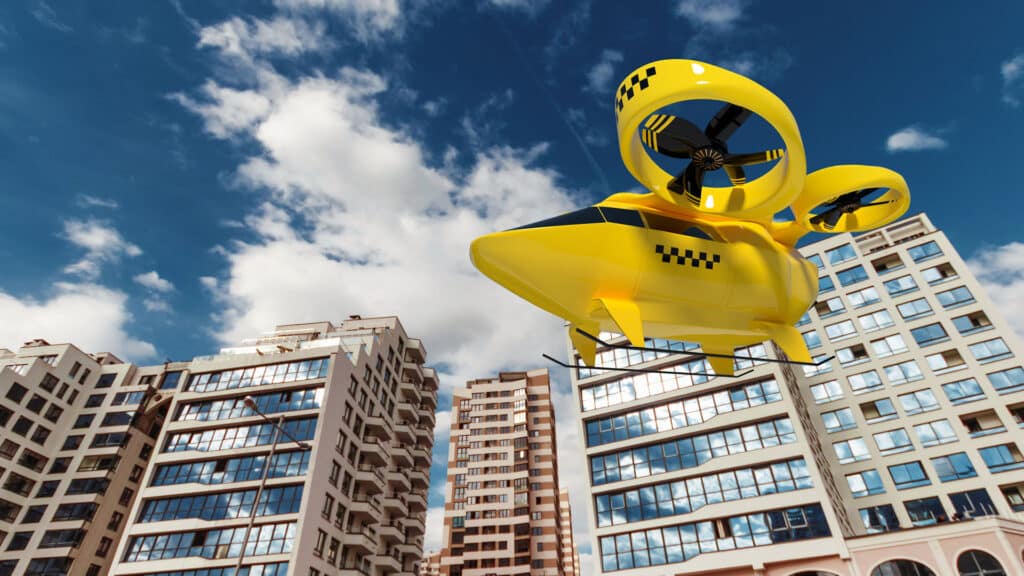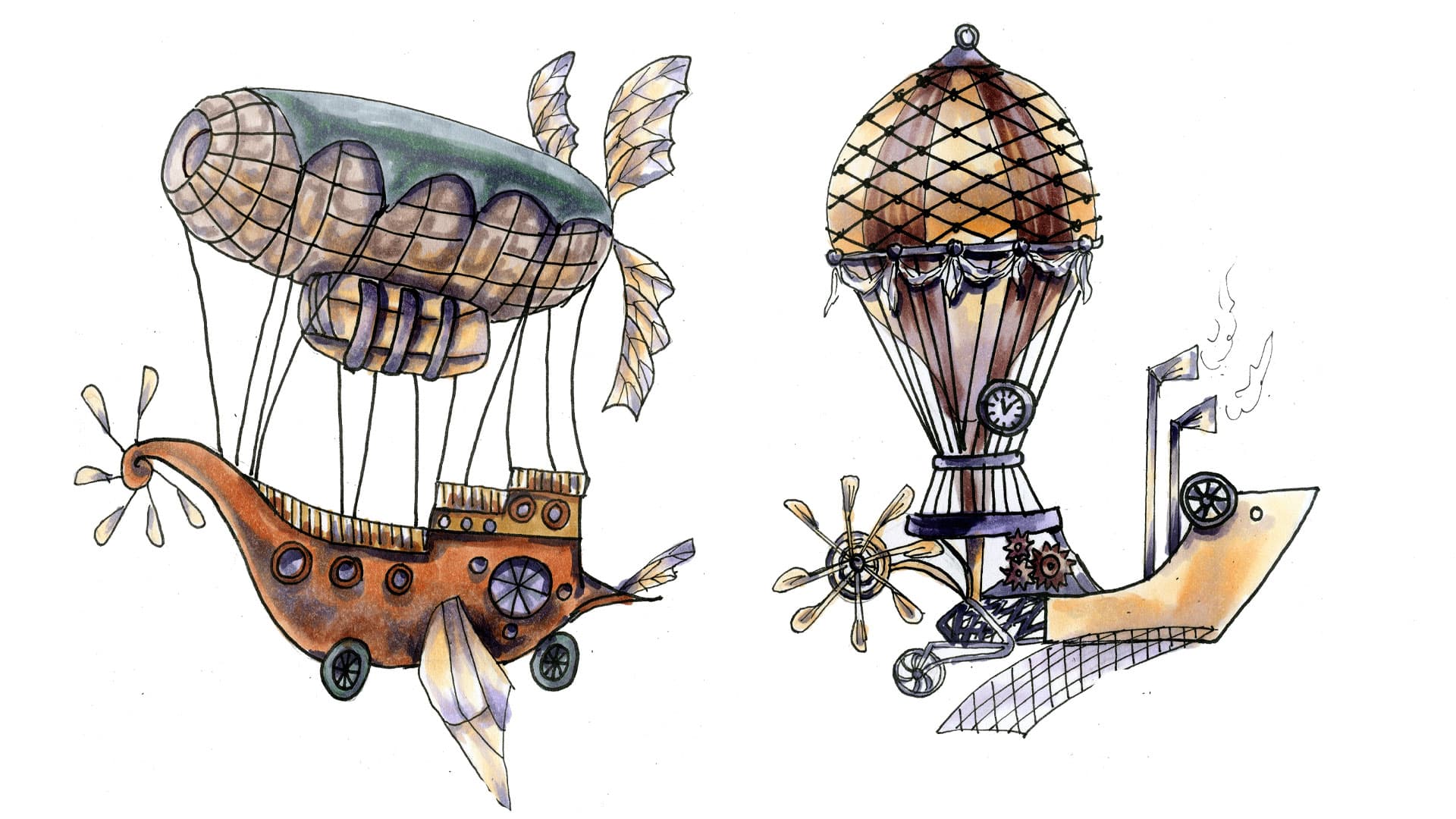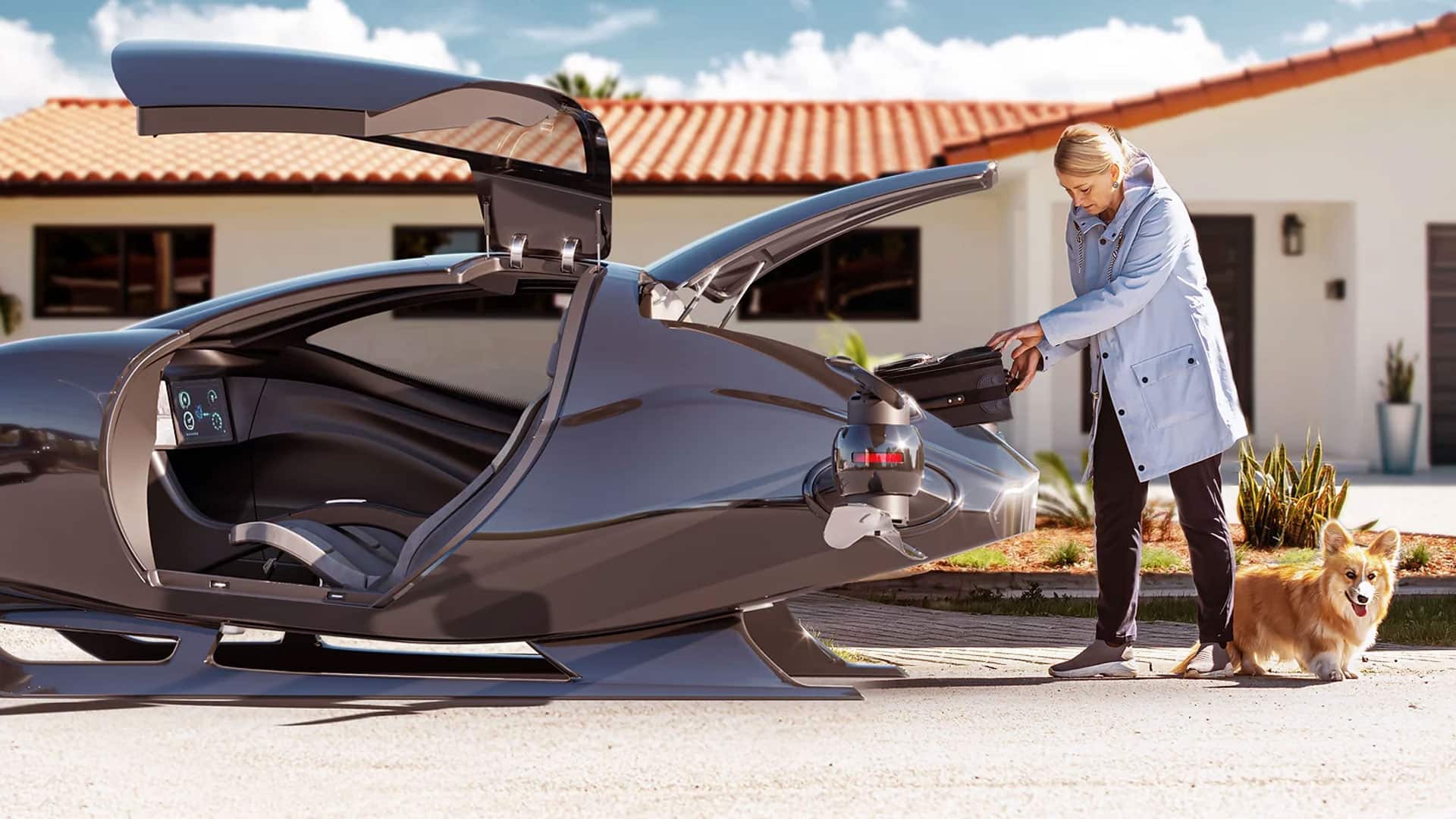
The Evolution of Urban Air Mobility
How eVTOLs are Changing City Transport
“Cars will likely dominate urban travel, pushing back public transit. Small neighborhood vehicles and specialized services might appear in medium-density areas. Regional centers will continue to grow, posing challenges for future transportation planning.” said an old article by Robert A. Makofski.
We can say that this article, which dates back to 1982, was definitely prophetic. Nowadays, almost all urban centers are congested by traffic and suffocated by the polluting products that it produces. Without considering the hours lost every year to make even the smallest, but necessary trips.
Some cities are taking action, digging more subway networks, closing large areas to private traffic, reactivating old, abandoned bus lines. Other cities are proposing innovative solutions such as ferry services, urban funiculars and bike paths for alternative mobility.
Now, imagine a world where traffic jams are a thing of the past, and your daily commute could soar above the city instead of crawling through it. That’s the promise of Urban Air Mobility (UAM).
UAM revolves around a new generation of flying vehicles called eVTOLs (electric Vertical Take-Off and Landing) These compact, electric aircraft can take off and land vertically, just like a helicopter, but with quieter operation and potentially lower costs. This opens the door for a whole new transportation network in our cities.
Think of eVTOLs as flying taxis. They could whisk you between the city center and suburbs, connect airports to business districts, or even offer scenic tours. They hold the potential to revolutionize urban transportation, especially in congested areas.

History and development of eVTOL technology and its potential impact on urban transport.
The Origins of Urban Air Mobility
The Dream Takes Flight: A Look at Urban Air Mobility’s Origins
The concept of zipping through cityscapes in a personal flying machine has captivated imaginations for over a century. This dream, now taking a more concrete form, is known as Urban Air Mobility (UAM). But UAM’s roots go deeper than you might think.
Early Visions (1900s):
The early 20th century saw a flurry of “flying car” concepts. Inventors like Glenn Curtiss dreamt of machines that could take off and land vertically, foreshadowing the VTOL (Vertical Take-Off and Landing) technology crucial for UAM.

Helicopter Era (1950s-1980s):
Helicopter services emerged in some major cities, offering a glimpse of what UAM could be. While convenient, limitations like noise and cost restricted their widespread adoption.
Technological Advancements (2000s-Present):
Recent years have seen a surge in UAM development driven by advancements in:
- Battery technology: Improved batteries offer longer range and flight times for electric vehicles.
- Electric motors: Powerful and efficient electric motors are key for quieter and cleaner operation.
- Autonomous flight control systems: These systems could pave the way for safer and more accessible UAM options.
The Future of UAM:
Today, numerous companies are developing eVTOLs (electric VTOLs), the next generation of flying vehicles for urban environments. While challenges remain in terms of regulation, infrastructure, and public acceptance, UAM holds the potential to revolutionize urban transportation.
The Birth of eVTOLs
From Science Fiction to Soaring Reality
Remember those Jetsons cartoons, where flying cars zipped effortlessly between chrome skyscrapers? Well, buckle up, because that futuristic vision is no longer just science fiction. We’re witnessing the birth of a new era in transportation: the era of eVTOLs.
eVTOL stands for Electric Vertical Take-Off and Landing. These compact, electric aircraft are revolutionizing the concept of urban mobility. Imagine a silent, agile vehicle that can take off and land vertically, just like a helicopter, but with the eco-friendliness and efficiency of an electric car. This is the potential of eVTOLs.
The birth of eVTOLs isn’t a singular moment, but rather a culmination of factors. It began with the early 20th century’s dream of “flying cars” and the development of VTOL technology. Recent advancements in battery technology, electric motors, and autonomous flight control systems have finally made this dream a feasible reality.
Let’s take a closer look at the birth of these revolutionary aircraft.

First Prototypes Take Flight (Early 2000s):
The early 2000s saw a new wave of interest in personal flying machines. Pioneering companies like Terrafugia and Ehang unveiled the first eVTOL prototypes. These early models were mostly proof-of-concept, but they laid the groundwork for future advancements. Imagine small, single-passenger vehicles with limited range, but the potential for a quieter and more efficient flying experience was undeniable.
Innovations in Design (2010s-Present):
As battery technology improved and electric motors became more powerful, eVTOL designs became more sophisticated. Companies explored various configurations, like multicopter designs with multiple rotors for increased stability, or tilting-wing designs that could transition from vertical takeoff to horizontal flight for greater range. These innovations aimed to address early limitations, making eVTOLs more practical for urban transportation.
Key Players Emerge (2010s-Present):
The dream of UAM has attracted a diverse range of players. Established aerospace giants like Boeing and Airbus are investing in eVTOL development, leveraging their expertise in aircraft design and manufacturing. New startups like Joby Aviation, Volocopter, Archer and Lilium are also making waves, bringing fresh perspectives and agility to the field. This influx of talent and investment is pushing the boundaries of eVTOL technology at an unprecedented pace.
The birth of eVTOLs is a story of continuous innovation and collaboration. From the first prototypes to the latest designs, these flying vehicles are poised to transform the way we navigate our cities.
Current Developments in Urban Air Mobility
Taking Flight in the Real World:
The dream of Urban Air Mobility (UAM) is no longer confined to science fiction. We’re now witnessing exciting developments as eVTOLs (electric Vertical Take-Off and Landing) inch closer to real-world applications. Let’s explore some key areas shaping the current UAM landscape.

Pilot Programs and Trials:
Cities around the world are actively participating in pilot programs and trials. These initiatives test the feasibility and safety of eVTOL operations in urban environments. Companies like Volocopter and EHang are partnering with cities like Dubai and Singapore to conduct trial flights. These programs provide valuable data on noise levels, air traffic management, and public acceptance, paving the way for wider adoption.
The Regulatory Landscape:
Safety is paramount in UAM. Regulatory bodies like the Federal Aviation Administration (FAA) in the US and the European Union Aviation Safety Agency (EASA) are developing frameworks specifically for eVTOL operations. These frameworks address issues like certification standards, air traffic control integration, and pilot training. Collaboration between regulators, industry leaders, and communities is crucial for establishing a safe and efficient regulatory environment.
Public Perception and Adoption:
Public acceptance will play a significant role in the success of UAM. Addressing concerns about noise, safety, and privacy is essential. Public awareness campaigns that educate citizens about the benefits and safety measures of eVTOLs are being implemented. Additionally, community engagement plays a vital role in shaping UAM infrastructure and ensuring widespread adoption.
The current developments in UAM are a testament to the rapid progress being made. Pilot programs, evolving regulations, and a growing public conversation are all propelling eVTOLs closer to becoming a reality in our cities.
Benefits of eVTOLs in City Transport
A Bird’s-Eye View of the Future:
Imagine a future where rush hour gridlock is a thing of the past, and commutes are measured in minutes, not hours. That’s the potential of eVTOLs (electric Vertical Take-Off and Landing) vehicles in city transport. Let’s explore some key benefits that eVTOLs could bring to our urban landscapes.

Efficiency and Speed:
eVTOLs promise to revolutionize urban mobility by offering unparalleled efficiency and speed. By taking advantage of the airspace, they bypass congested roads, significantly reducing travel times. Imagine traveling across a sprawling city in a fraction of the time it currently takes. This could not only improve commutes but also unlock new possibilities for business and leisure travel within cities.
Environmental Impact:
Sustainability is a major concern in our cities. eVTOLs, powered by electric motors, have the potential to be significantly quieter and produce fewer emissions compared to traditional gasoline-powered vehicles. This could lead to cleaner air and a quieter urban environment. Additionally, eVTOL infrastructure requires less land use compared to traditional road networks, further contributing to a more sustainable future.
Economic Opportunities:
The rise of UAM presents exciting economic opportunities. eVTOL development and operation have the potential to create new jobs in manufacturing, maintenance, and piloting. Furthermore, by improving urban mobility and accessibility, UAM could unlock economic potential in previously underserved areas. Imagine faster connections to airports or the ability to reach remote parts of a city for business or emergency services. eVTOLs could create a more dynamic and interconnected urban landscape.
The potential benefits of eVTOLs in city transport are undeniable. From increased efficiency and speed to environmental advantages and economic opportunities, these flying vehicles hold the promise of transforming the way we navigate our cities. However, challenges remain in terms of infrastructure development, public acceptance, and ensuring safe and equitable implementation. As UAM continues to evolve, it will be fascinating to see how these innovative vehicles shape the future of urban mobility.
Challenges and Barriers
Keeping Our Feet on the Ground While Reaching for the Skies:
While the potential benefits of eVTOLs in city transport are significant, there are challenges and barriers that need to be addressed before widespread adoption becomes a reality. Here are some key hurdles that eVTOL development currently faces:

Technical Challenges:
eVTOL technology is still under development. Ensuring the safety, reliability, and efficiency of these vehicles is paramount. Battery range remains a limitation, affecting flight times and potentially requiring frequent recharging infrastructure. Noise levels also need to be addressed to minimize disruption for urban communities. Additionally, developing robust autonomous flight control systems will be crucial for wider public acceptance and potentially reducing operational costs.
Infrastructure Needs:
A whole new ecosystem needs to be established to support eVTOL operations in cities. This includes developing vertiports, designated landing and take-off pads for eVTOLs. These vertiports need to be strategically located and integrated with existing transportation networks. Additionally, air traffic management systems need to be adapted to accommodate eVTOLs, ensuring safe and efficient airspace utilization for both traditional aircraft and these new flying vehicles.
Regulatory and Legal Hurdles:
Safety is a top priority when it comes to air travel. Regulatory bodies around the world are still developing frameworks for eVTOL certification and operation. These frameworks need to address issues like pilot training requirements, maintenance standards, and air traffic control integration. Furthermore, legal considerations regarding noise restrictions, privacy concerns, and liability in case of accidents need to be addressed. Collaboration between regulators, industry leaders, and the public will be crucial in establishing a comprehensive and effective regulatory environment for UAM.
Addressing these technical challenges, infrastructure needs, and regulatory hurdles is essential for the safe and successful integration of eVTOLs into our cities. As UAM continues to evolve, innovative solutions and collaborative efforts will be key to overcoming these barriers and unlocking the full potential of eVTOLs in revolutionizing urban transportation.
The Future of Urban Air Mobility
Soaring Towards a New Horizon:
Urban Air Mobility (UAM) paints a vivid picture of a future where cities are no longer choked by traffic, but abuzz with the hum of electric rotors. Let’s take a glimpse into what the next 20-30 years might hold for UAM, exploring its potential applications, innovative uses, and global impact.
Vision for the Future (20-30 years):
Imagine a world where eVTOLs (electric Vertical Take-Off and Landing) vehicles have become a seamless part of urban life. Extensive networks of vertiports dot cityscapes, offering convenient access to on-demand air taxis. Commutes are measured in minutes, not hours, as people zip across sprawling metropolises. Personal eVTOL ownership might become a reality for some, offering a new level of freedom and flexibility. Additionally, autonomous eVTOLs could become commonplace, further increasing accessibility and potentially lowering operational costs.

Innovative Uses (beyond passenger transport):
The potential applications of eVTOLs extend far beyond passenger transport. Imagine these flying vehicles delivering urgent medical supplies or performing search and rescue missions in congested areas. They could revolutionize cargo delivery, offering faster and more efficient options for businesses. Furthermore, eVTOLs could be used for aerial inspections of infrastructure, such as power lines or wind turbines, improving safety and efficiency.
Global Impact:
The impact of UAM will likely be felt around the world. Developing nations could benefit from eVTOLs by connecting remote areas previously inaccessible by traditional means. This could unlock economic opportunities and improve access to essential services in these regions. Additionally, UAM could play a role in disaster relief efforts, providing rapid transportation of personnel and supplies to affected areas.
Conclusion
A Journey from Dream to Reality:
The concept of Urban Air Mobility (UAM) has taken us on a fascinating journey, from the fantastical visions of flying cars to the concrete developments of eVTOLs (electric Vertical Take-Off and Landing) vehicles. We’ve explored the history of UAM, from early prototypes to current pilot programs, and delved into the potential benefits and challenges associated with this revolutionary technology.
The future of UAM is bright, with the potential to transform our cities into dynamic, interconnected landscapes. Imagine a world where traffic jams are a relic of the past, replaced by the efficient hum of eVTOLs navigating the skies. However, this vision requires overcoming technical hurdles, establishing robust infrastructure, and navigating complex regulatory landscapes.

The evolution of UAM is a story of continuous innovation and collaboration. As technology advances, regulations adapt, and public perception evolves, eVTOLs have the potential to become a reality in our cities. Whether it’s reducing congestion, improving accessibility, or minimizing environmental impact, UAM offers a glimpse into a future where mobility takes flight. The journey from dream to reality is well underway, and the skies above us may soon become a testament to human ingenuity and our desire to push the boundaries of transportation.
In the world of Urban Air Mobility (UAM), Aeroauto isn’t envisioned as a developer of eVTOL technology itself. Instead, our role lies in facilitating the connection between potential owners and the various eVTOL models from different manufacturers. Aeroauto act as a marketplace, simplifying the process of finding and acquiring these new flying vehicles. We offer eVTOL for personal or commercial use, including air taxi services and corporate fleets. As UAM takes flight, Aeroauto definitely play a significant role in streamlining consumer adoption and shaping the future of personal eVTOL ownership.
Aeroauto also, has a bright future role in vertiport design or operation. Our collaboration with municipalities or infrastructure companies will leverage our marketplace expertise to ensure vertiports cater to the diverse needs of eVTOL operators and passengers, creating a seamless user experience from purchase to flight.
